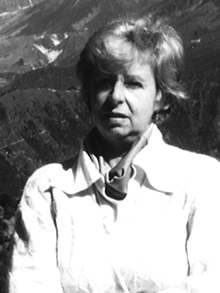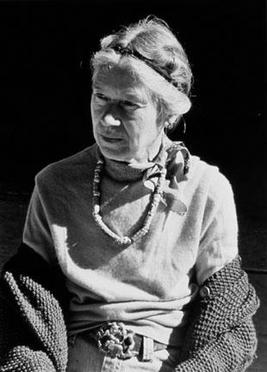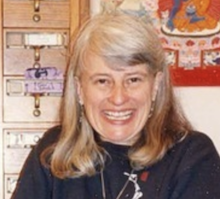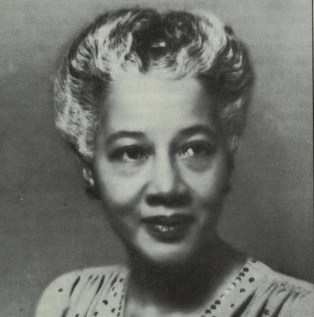Related Research Articles
Feminist separatism is the theory that feminist opposition to patriarchy can be achieved through women's separation from men. Much of the theorizing is based in lesbian feminism.

Suzanne Chouinard Martel was a French Canadian journalist, novelist and children's writer.

The Ladder was the first nationally distributed lesbian publication in the United States. Published from 1956 to 1972, The Ladder was the primary monthly publication and method of communication for the Daughters of Bilitis (DOB), the first lesbian organization in the US. It was supported by ONE, Inc. and the Mattachine Society, with whom the DOB retained friendly relations. The name of the magazine was derived from the artwork on its first cover, simple line drawings showing figures moving towards a ladder that disappeared into the clouds.

Elsa Gidlow was a British-born, Canadian-American poet, freelance journalist, philosopher and humanitarian. She is best known for writing On a Grey Thread (1923), the first volume of openly lesbian love poetry published in North America. In the 1950s, Gidlow helped found Druid Heights, a bohemian community in Marin County, California. She was the author of thirteen books and appeared as herself in the documentary film, Word Is Out: Stories of Some of Our Lives (1977). Completed just before her death, her autobiography, Elsa, I Come with My Songs (1986), recounts her life story. It is the first complete-life, lesbian autobiography published where the author "outs" herself and does not employ a pseudonym.
Rites was a Canadian magazine, published for gay, lesbian, bisexual, and transgender communities in Canada from 1984 to 1992.

The Canadian Institute of Mining, Metallurgy and Petroleum (CIM) is a not-for-profit technical society of professionals in the Canadian minerals, metals, materials and energy industries. CIM's members are convened from industry, academia and government.

Steve Requin is a Canadian cartoonist from Beloeil, Quebec.
This is a timeline of notable events in the history of the lesbian, gay, bisexual and transgender (LGBT) community in Canada. For a broad overview of LGBT history in Canada see LGBT history in Canada.

Amazones d'Hier, Lesbiennes d'Aujourd'hui is the name of a quarterly French language magazine published starting 1982 by a lesbian collective in Montreal made of Louise Turcotte, Danielle Charest, Genette Bergeron and Ariane Brunet.
Louis-Adolphe Paquet was an influential French-Canadian theologian from the late 19th early 20th century, and a major North American proponent and actor in the rebirth of Neo-Scholasticism. Although nowhere as politically influential as his uncle Benjamin Pâquet had been, he was well respected and his opinion helped shape the doctrines and policies of the Canadian church in the early 20th century.
Although same-sex sexual activity was illegal in Canada up to 1969, gay and lesbian themes appear in Canadian literature throughout the 20th century. Canada is now regarded as one of the most advanced countries in legal recognition of lesbian, gay, bisexual, and transgender (LGBT) rights.

Druid Heights was a counterculture enclave in Marin County, California, U.S., The property was purchased in 1954 by poet Elsa Gidlow, and subsequently the land was split with carpenter Roger Somers and his wife Mary. In 1956, Elsa named her portion Druid Heights and today the entire site is called by this moniker although in practice the neighbors seldom used the name. In actuality, the community was not a monolith, but the neighborhood shared common values and responsibilities concomitant with the remote site's lack of services. It had no city water system, no sewers, and no city maintenance for the three mile dirt road that gave them access to their properties. The neighbors, including others along the road, had to pool money and resources to maintain these vital services and these challenges demanded they work together in harmony. The remoteness and uniqueness of the site attracted various countercultural movements and many figures of the San Francisco Renaissance.

Martha Shelley is an American activist, writer, and poet best known for her involvement in lesbian feminist activism.

Celeste (Celestia) West was an American librarian and lesbian author, known for her alternative viewpoints in librarianship and her authorship of books about lesbian sex and polyfidelity. She herself was polyamorous.
Roswell George Mills was a Canadian journalist, poet and magazine publisher. A friend and colleague of poet Elsa Gidlow, he is the first known gay man in Canadian history whose life and sexual orientation is attested through biographical literature rather than court records of a sodomy trial.

Fag Rag was an American gay men's newspaper, published from 1971 until circa 1987, with issue #44 being the last known edition. The publishers were the Boston-based Fag Rag Collective, which consisted of radical writers, artists and activists. Notable members were Larry Martin, Charley Shively, Michael Bronski, Thom Nickels, and John Mitzel. In its early years the subscription list was between 400 and 500, with an additional 4,500 copies sold on newsstands and bookstores or given away.

Violet Winifred Leslie Henry Anderson, known professionally as V. Henry-Anderson, was a Scottish-born golfer and partner of poet Elsa Gidlow.

Isabel Grenfell Quallo was a Congolese-born British-American domestic worker and community activist known for her involvement in the development of Druid Heights, in Marin County, California. Born in the Congo Free State, she was educated in England and then moved with her mother to Kingston, Jamaica. Marrying at 16, she immigrated with her husband to New York City in 1914. Struggling with racism and her husband's mental illness, she supported her children by working as a domestic and waitress. Through contacts in the theater district, she made the acquaintance of writer Elsa Gidlow, becoming her lover for ten years. In their last two years together, Elsa purchased 5 acres of land south of Muir Woods. She then split the property with builder and jazz musician Roger Somers, and his wife Mary, and, initially with Isabel’s help, they fostered an atmosphere which would attract many of those involved in countercultural movements, active in the United States between 1950 and 1970.
References
- 1 2 3 Les Mouches fantastiques. OCLC 986992619.
- 1 2 3 4 5 6 7 8 9 "Canada's first gay rag" (PDF). Xtra! . Toronto: Pink Triangle Press. February 19, 2015.
- ↑ Gidlow, Elsa (1986). Elsa, I come with my songs: the autobiography of Elsa Gidlow . San Francisco: Booklegger Press. pp. 82-83. ISBN 0-912932-12-0. OCLC 11621381.
- ↑ "The Improbable Life and Loves of Elsa Gidlow". Kingston Whig-Standard . Kingston. March 23, 1988.
- ↑ Gidlow, p.83.
- 1 2 Faig, Ken Jr. (July 2006). "Lavender Ajays of the Red-Scare Period: 1917–1920" (PDF). The Fossil. 102 (4): 5–17.
- ↑ "Les Mouches Fantastiques | ArchivesSpace at the University of Iowa". aspace.lib.uiowa.edu. Retrieved 2018-08-27.